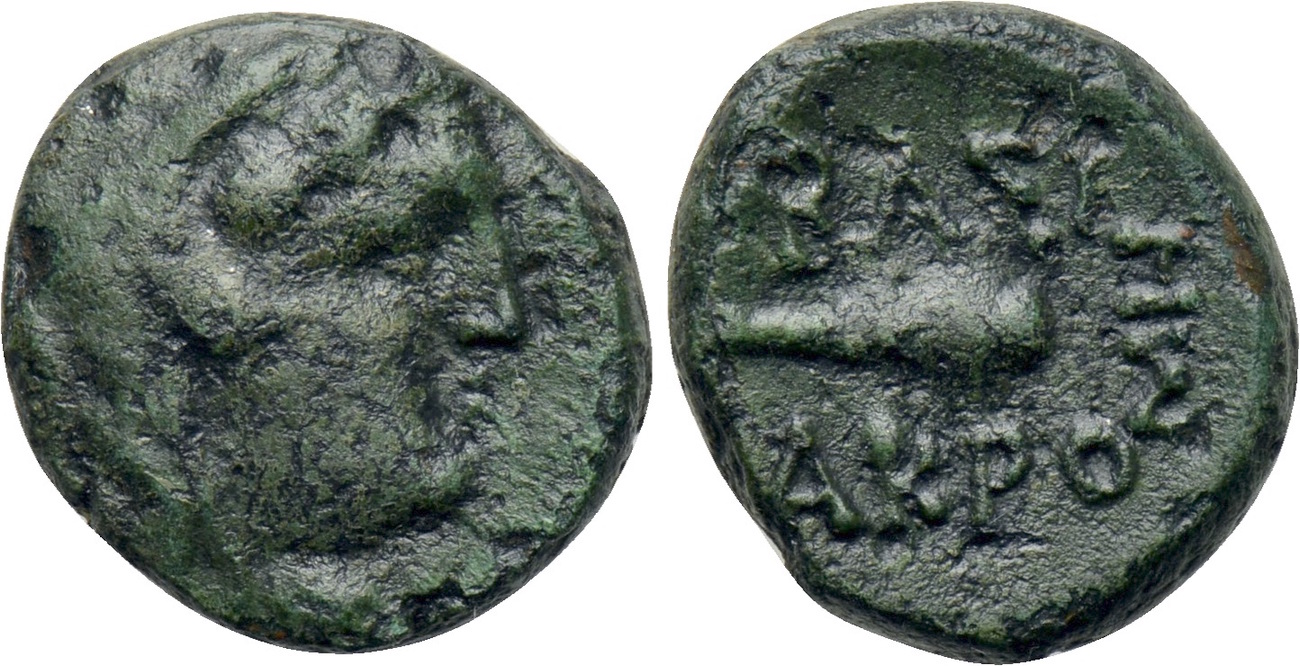Thrace (uncertain mint) (Akrosas), bronze, 3.0g (Heracles/club) (195-190 BCE)
From SILVER
195 BCE - 190 BCE Bronze
Description
| ObverseInscription or printing placed on the obverse.: | Head of Herakles right, wearing lion skin |
| ReverseInscription or printing placed on the reverse.: | BAΣI / AKPO (Greek).Club, MH to right |
Mint and issuing power
| MintIdentifies the place of manufacture or issue of a numismatic object.: | Thrace (uncertain mint) | Ancient regionAncient region.: | Thrace | Modern countryModern country: Bulgaria | AuthorityIdentifies the issuing power. The authority can be "pretended" when the name or the portrait of X is on the coin but he/she was not the issuing power. It can also be "uncertain" when there is no mention of X on the coin but he/she was the issuing power according to the historical sources: | Akrosas, Scythian kings |
Chronology
| FromIdentifies the initial date in a range assigned in a numismatic context. | 195 BCE | toIdentifies the final date in a range assigned in a numismatic context.. | 190 BCE | PeriodTime period of the numismatic object.: Hellenistic 323-30 BC |
Physical description
| MetalThe physical material (usually metal) from which an object is made.: | Bronze |
Median weightMedian of the weights of numismatic objects (in grams). in grams | 3.00 | DenominationTerm indicating the value of a numismatic object. Examples: tetradrachm, chalkous, denarius.: | StandardStandard.: |
Image

S1973 Akrosas 4 Heracles club.jpg [1]
References
| Die study referencePublication of the study: | Draganov 20151Draganov 2015, p. 218, n° 466-469, 477-483 | ||
| Coin series referenceReference to coin series study: | HGC 3.22HGC 3.2, n° 2020 | ||
| Coin series web referenceCoin series web references: | |||
Obverse dies distribution
| FrequencyFrequency of specimen in distribution. ᵖ | Number of obversesNumber of obverse dies. ᵖ (o) | % (o) | Number of coinsNumber of coins. (n) | % (n) | Die nameName(s) of the die(s). |
| 4 | 1 | 50 | 4 | 36.36 | 15 |
| 7 | 1 | 50 | 7 | 63.64 | 16 |
| Total | 2 of 2 | 100 | 11 of 11 | 100 |
Reverse dies distribution
no distribution is available
Quantification
| Number of obversesNumber of obverse dies. ᵖ (o) | 2 | Number of singletons (o1)The number of singleton coins. ᵖ | |
| Number of reverse diesNumber of reverse dies. (r) | 5 | Number of coinsNumber of coins. (n) | 11 |
| Coins per obverse dieNumber of coins per obverse die. (n/o) | 5.5 | Coins per reverse dieNumber of coins per reverse die. (n/r) | 2.2 |
| Reverse per obverse ratioRatio of obverse dies divided by reverse dies. (r/o) | 2.5 | Percentage of singletons (o1)number of coins (n) divided by the number of singletons (o1) ᵖ | % |
| Original number of dies (O) (Carter 1983 formula)The estimation of the number of coins according to Carter 1983 ᵖ | 2.18 | Coins struck if 20,000 as average productivity per dieCoins made if the average productivity for obverses (according to Carter) is 20,000. ᵖ | 43,600 |
| Original number of dies (O) (Esty 2011 formula)The estimation of the number of coins according to the singleton formula in Esty 2011 ᵖ (O) | 2.44 | Survival rate if 20,000 as average productivity per dieSurvival rate if average productivity is 20,000. ᵖ | 0.00025 |
| Coverage (o = % of O) (Esty 1984 formula)Esty 1984 - coverage (% of O) ᵖ (o = % of O) | % | Die productivity if survival rate 1/2,000Average productivity if survival rate is 1/2,000. ᵖ | 10,091.74 |
| Weight of silver (in kg) if 20,000 coins per die (O = Carter formula)Carter 1983 * Median weight * 20000 (*10 if gold or electrum) ᵖ | n.a. | Die productivity if survival rate 1/5,000Average productivity if survival rate is 1/5,000. ᵖ | 25,229.36 |
Remarks
Most likely one single workstation Likely military Bronze types for Scythina kings are often limited to one single die
References
- ^ Draganov, Dimitar (2015), The coinage of the Scythian kings in the West Pontic area, Sofia, Bobokov Bros. Foundation, 309 p.
- ^ Hoover, Oliver D. (2017), Handbook of Coins of Macedon and Its Neighbors. 3. Part 2: Thrace, Skythia, and Taurike, Sixth to First Centuries BC, Lancaster-London, xix, 232 p.